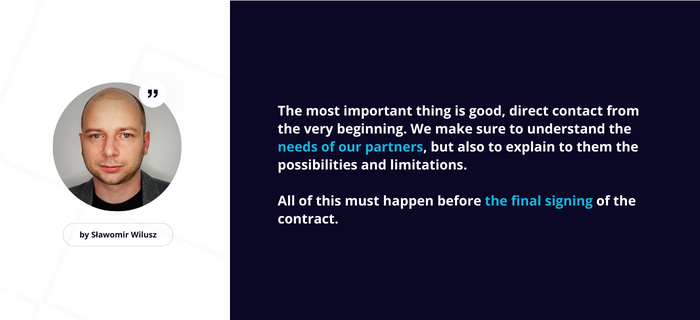Issues with schedule management in IT projects and frequent delays occur right from the planning phase, leading to potentially irreversible losses. Identifying the root causes of these delays can aid in selecting the appropriate supplier, collaboration approach, and mitigating the risk of exceeding the allocated schedule and budget.
Table of Contents:
- #1 Sales Process Issues
- #2 IT Project Specification
- #3 Backup Plan
- #4 Methodology vs. Reality
- #5 Expert Team
Depending on whom you ask, IT projects typically face challenges due to poorly defined goals in the sales process, inadequate technical specifications, lack of communication between the supplier and the client, or the absence of skilled specialists.
The truth lies somewhere in the middle, and unfortunately, schedule delays are typically considered a necessary evil.
Delays primarily result in increased budget. According to a 2020 study conducted by Wellingone, 57% of respondents admitted to exceeding the project budget.
In the book “Eternal Delay” by Marcin Dąbrowski, an IT project practitioner, the author highlights that project delays are closely linked to the sales process and the conflict of interest between the seller, the development team, and the company owners.
Additionally, the adoption of agile methodologies is still incomplete. Only 53% of respondents in the PMI institute’s survey stated that they use one or more Agile techniques, with the daily standup being the most common.
However, blindly relying on methodologies can negatively impact the schedule, especially if a small team spends excessive time on administrative tasks like filling in Jira.
If you’re feeling overwhelmed by the complexity, don’t worry. Below is a specific overview of the topic, along with proposed solutions.
#1 Sales Process Issues
The sales process is often overlooked when discussing budget and schedule issues in IT projects. The signing of the first contracts determines the scope, time, and cost, which greatly impact how the project is carried out.
Unfortunately, hidden conflicts of interest and wishful thinking frequently lead to unrealistic schedules from the start.
- The seller’s goal on the supplier’s side is to sell and achieve their KPIs. However, they do not receive a commission for delivering products on schedule.
- The client’s goal is to find the best offer, frequently the cheapest one that offers the most value.
In addition, the CEO of the company may prioritize landing a big client over realistic deadlines submitted by the sales department. This sets the project up for failure, causing dissatisfaction for both parties after the contract is signed.
Solution: Establish a common goal for the sales department, supplier, and client – delivering the best possible product.
If each party takes responsibility for delivering the product, unrealistic schedules and estimates can be avoided, benefiting both the client and the supplier.
Company Size Matters
At this stage, it is worth paying attention to the size and specialization of the company you plan to cooperate with. A small client may get lost with a large corporate supplier, and it will be difficult to align on the goal.

#2 IT Project Specification
Another Achilles’ heel is the technical specification of the project – done hastily, as part of wishful thinking on both sides or without expertise from the supplier. In the process, it turns out that adding a simple module takes four months instead of one.
To improve the project specification, consider the following guidelines:
- Use clear and concise language to avoid misunderstandings between both parties.
- Include user stories to describe how the system will be used by users.
- Distinguish between functional and non-functional requirements to effectively prioritize and manage them.
- Ensure each requirement is unambiguous and clearly defined using specific and measurable criteria.
- Document any assumptions or constraints that may affect the requirements or development process.
- Regularly conduct reviews and validations of the SRS with stakeholders to identify gaps or inconsistencies.
- Maintain version control of the SRS document to track changes and updates.
- Organize the SRS document in a logical and structured manner for easy navigation.
In addition, it is recommended to prepare a detailed project specification with the support of experts to ensure its quality and accuracy.
#3 Backup Plan
We recently wrote about our interns working on an AI project, in which data is divided in specified proportions from the start. Data for AI projects is crucial, just like the budget is crucial for IT projects.
It is worth thinking about the budget similarly and dividing it before starting the project. If you spend 100% of the budget on early MVP, it will be difficult to continue working.

- Budget. Precisely planning the budget with a buffer increases the likelihood of success.
- Schedule. A precisely planned schedule with a buffer ensures that the planned scope will be delivered, and the budget will not be inflated due to delays.
Solution: plan the budget and schedule with a buffer.
#4 Methodology vs. Reality
Agile methodologies for digital projects have been the gold standard for years, despite incomplete adoption in the IT industry. Clinging rigidly to a methodology without adapting it to the needs of a specific project can be detrimental.
Side effects of blindly implementing agile methods include:
- Trying to adapt the production cycle to two-week iterations.
- “The project is agile” = no schedule and time pressure.
- Sticking rigidly to a chosen methodology, even if the project could be done better in another way.
- The organization is not ready for agile methods, but still tries to implement them.
In practice, the best solution for project management is one that ensures that the project is delivered on time and within the given budget (going back to the main idea, which is the goal).
Understanding on both sides that there is no one-size-fits-all solution to the production process will make it easier to select a method that is tailored to the project.

Solution: pick a methodology that fits the project.
Ways to work with software house
There are different models of working with software houses, which can be simplified into:
- Fixed Price. The price and scope are determined at the beginning and do not change.
- Time & Material. The client is billed for the time worked by specialists.

#5 Expert Team
Lastly, one of the factors influencing delays is the expert team. Assuming that the project was well planned from the start, the main element in its implementation is the team of specialists building the product.
High-quality specialists are:
- Efficient in their work, which is very important when billing hourly.
- Require fewer revisions.
- Solve problems quickly.
- Transfer knowledge and share experience.
It is a great idea to hire experts specialized in specific technologies and with experience in projects of a scale that matches your needs.
For example, even experienced companies subcontracted by large corporations may not know the problems that startups are struggling with (and vice versa).
Solution: Seek companies that have experience n your industry and specialists on board.
The Human Factor
From the above, one thing is clear: delays are caused by people. Due to wishful thinking, lack of expertise, and conflicting interests. That’s why we engage in the project planning process from the earliest stages, and the CEO of Fingoweb is available to all our partners.








